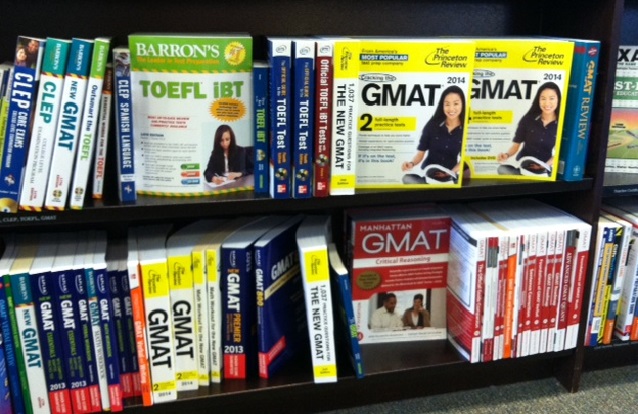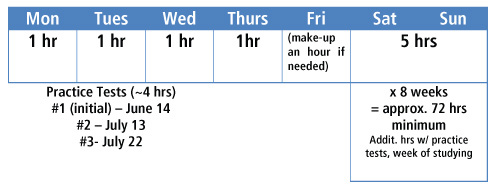Ready, Set, GMAT

Four simple letters- one big test. The GMAT (Graduate Management Admissions Test) seems to strike fear in the hearts of many TMMBA applicants. While I am very familiar with the test, I will admit: I’ve never taken the GMAT myself. That’s all about to change though. My intent is to put myself in your shoes, and see the GMAT from a test-taker’s perspective. Over the next 8 weeks, I’ll be blogging about my experience with the test from start to finish- passing along my tips and thoughts during the process. My hope is that with a look inside the GMAT, TMMBA applicants will see that while the test is a big task, it may not be as bad as you think.
In a survey of our TMMBA Class of 2014, 36% of students reported spending 1-2 months studying for their GMAT. Consequently, I have scheduled my test for end of July, giving me just under two months to study. To simulate the experiences that many of our students go through, I’ll be studying during non-work hours, and using many of the study techniques that we recommend at TMMBA.
My dad used to tell me that the greatest time wasted is the time it takes to get started. So far, I feel like this is extremely true with the GMAT. Once I finally got up the nerve to schedule my date for the test and get my study materials in order, it felt like I was ready to go. Here’s what I did to get the ball rolling:
1. Schedule the test. Just do it! This first step is crucial since it helps you determine your study timeline. Also, there’s something about committing to a test date that gets you motivated to crack open those books.
I recommend evaluating your calendar of work and personal commitments as well as taking a look at the deadlines that you’re trying to meet. For example, with the TMMBA final deadline on September 1, many of our students take their GMAT in late July or August. Remember that dates fill up quickly- especially for weekend tests. There are two testing centers in the Seattle area (one by Northgate, one in Renton) and they administer tests every day of the week, with different time options.
To register, I logged onto MBA.com and clicked the link to “Register Today.” After creating my GMAT profile, it was easy to schedule an appointment based on their calendar of availability. A word of caution: make sure you’re ready to commit to your date, since you pay $250 to schedule, and you are not able to cancel or change dates without additional fees.
2.  Get your study materials. GMAT studying usually happens one of two ways- self study or private coaching/prep courses. Either way can be effective, but it depends on many factors, like time, money, and the level of help that you need. For TMMBA students, 88% of our current class chose the self-study option, and I intend to go that route as well.
Get your study materials. GMAT studying usually happens one of two ways- self study or private coaching/prep courses. Either way can be effective, but it depends on many factors, like time, money, and the level of help that you need. For TMMBA students, 88% of our current class chose the self-study option, and I intend to go that route as well.
To begin, I researched various GMAT prep books. Our students recommend the Official GMAT Guide, Kaplan, The Manhattan Guide, and the Princeton Review among their top choices. Whichever publisher you choose, here are a few things that I was looking for:
- Make sure your book(s) cover all 4 GMAT test parts – Quantitative, Verbal, Analytical Reasoning, and Integrated Reasoning. The Integrated Reasoning portion of the test was released in June 2012, so make sure you have an updated version (especially of concern if you’re buying used copies or borrowing from the library).
- Look for practice tests- both online and in the book. Some of the best books I found included as many as 8 full-length practice tests online. Make sure there are plenty of questions available for you to work through.
- Evaluate options for digital books/materials – the book I finally settled on came with an IPad version to download. Really helpful when you don’t feel like carrying a 1,000 page book around with you for 2 months.
Also note that when you register for your GMAT, you will be able to access introductory software that contains practice questions and tests as well. It’s a great resource, though you may find you need an additional book or two as well.
3. Determine a study plan. Now- I had the book, I had the test date- time for a plan. Most coaches and GMAT blogs will always recommend coming up with a study plan, and I agree. I needed a  consistent schedule that I could commit to and plan around. With my test date scheduled, I worked backwards from that date and came up with a rough outline of my study schedule (at right). Note that for me, 72 hrs seemed to be a realistic goal in terms of time commitment and the score I was aiming for. This total hours number will be different for everyone. Just be sure to have a goal and plan accordingly (then stick to it!)
consistent schedule that I could commit to and plan around. With my test date scheduled, I worked backwards from that date and came up with a rough outline of my study schedule (at right). Note that for me, 72 hrs seemed to be a realistic goal in terms of time commitment and the score I was aiming for. This total hours number will be different for everyone. Just be sure to have a goal and plan accordingly (then stick to it!)
With those three steps taken care of, I’m well on my way to some (hopefully) successful studying. Stay tuned for more posts in the coming weeks about study strategies, tips, and best practices.
Are you a prospective student studying for the GMAT? Write a comment and let us know what your approach is!
